Study on Shearing Behavior of Circular Concrete-Filled CFRP (Carbon Fiber-Reinforced Plastics)-Steel Tube
Abstract
:1. Introduction
2. Design and Material Properties of Specimens
2.1. Design of Specimens
2.2. Material Properties
3. Loading and Measurement
4. Test Results and Analysis
4.1. Test Phenomenon
4.2. V-Δ Curves
4.3. τ-γ Curves
5. Finite Element Simulation
5.1. Comparison between Simulation Results and Test Results
5.1.1. Comparison of V-Δ Curve between Simulation Results and Test Results
5.1.2. Comparison of Fail Mode between Simulation Results and TEST Results
6. Analysis of the Whole Process of Stress
6.1. Typical V-Δ Curve
6.2. Maximum Principal Stress of Concrete
6.3. Stress of Steel Tube
6.4. Stress of CFRP
7. Parameter Analysis
Influence of Parameters
8. Bearing Capacity-Related Equation
8.1. Calculation Expression
8.2. Expression Validation
9. Discussion
10. Conclusions
- (1)
- The shear displacement curve of concrete-filled CFRP steel tube shear specimens can be divided into elastic stage, strengthening stage, and softening stage.
- (2)
- The shear displacement curve and failure mode of concrete-filled CFRP steel tube members under shear loading were simulated by ABAQUS, and the simulation results were in good agreement with the experimental results.
- (3)
- The typical V-Δ curve is divided into three stages and seven characteristic points were selected to analyze the stress distribution of the constituent materials in each stage and characteristic points.
- (4)
- The results of parameter analysis showed that the increase of steel yield strength or steel ratio can significantly improve the shear capacity, the increase of concrete compressive strength improved the bearing capacity, while the increase of transverse CFRP layers only slightly improved the bearing capacity. The increase of concrete compressive strength and steel content can significantly improve the stiffness of the specimen, and the increase of steel yield strength can improve the stiffness of the specimen.
- (5)
- The shear strength of concrete-filled CFRP steel tube was defined, and the formula for calculating the shear capacity of concrete-filled CFRP steel tube was proposed. The results of this formula were in good agreement with the experimental results, and the shear strength can pre-calculate the bearing capacity of concrete-filled CFRP steel tube under shear loading in engineering.
Author Contributions
Funding
Institutional Review Board Statement
Informed Consent Statement
Data Availability Statement
Conflicts of Interest
References
- Wang, Q.L.; Zhao, Y.H.; Gu, W. Presumption on the concrete filled circular CFRP-Steel composite tube structures. J. Shenyang Archit. Civ. Eng. Univ. 2003, 19, 272–274. [Google Scholar]
- Jin, L.; Fan, L.; Li, P.; Du, X. Size effect of axial-loaded concrete-filled steel tubular columns with different confinement coefficients. Eng. Struct. 2019, 198, 109503. [Google Scholar] [CrossRef]
- Martinelli, E.; Hosseini, A.; Ghafoori, E.; Motavalli, M. Behavior of prestressed CFRP plates bonded to steel substrate: Numerical modeling and experimental validation. Compos. Struct. 2019, 207, 974–984. [Google Scholar] [CrossRef]
- Chellapandian, M.; Prakash, S.S.; Rajagopal, A. Analytical and Finite Element Studies on Hybrid FRP Strengthened RC Column Elements under Axial and Eccentric Compression. Compos. Struct. 2017, 184, 234–248. [Google Scholar] [CrossRef]
- Ouyang, Y.; Kwan AK, H.; Lo, S.H.; Ho, J.C.M. Finite element analysis of concrete-filled steel tube (CFST) columns with circular sections under eccentric load. Eng. Struct. 2017, 148, 387–398. [Google Scholar] [CrossRef]
- Feng, R.; Chen, Y.; Wei, J.; Huang, J.; Huang, J.; He, K. Experimental and numerical investigations on flexural behaviour of CFRP reinforced concrete-filled stainless steel CHS tubes. Eng. Struct. 2018, 156, 305–321. [Google Scholar] [CrossRef]
- Che, Y.; Wang, Q.L.; Shao, Y.B. Compressive performances of the concrete filled circular CFRP-steel tube (C-CFRP-CFST). Adv. Steel Constr. 2017, 8, 311–338. [Google Scholar]
- Liu, L.; Lu, Y.Y. Axial bearing capacity of short FRP confined concrete-filled steel tubular columns. J. Wuhan Univ. Technol. Mater. Sci. 2010, 25, 454–458. [Google Scholar] [CrossRef]
- Li, S.Q.; Chen, J.F.; Bisby, L.A.; Hu, Y.M.; Teng, J.G. Strain efficiency of FRP jackets in FRP-confined concrete-filled circular steel tubes. Int. J. Struct. Stab. Dyn. 2012, 12, 75–94. [Google Scholar] [CrossRef]
- Teng, J.G.; Hu, Y.M.; Yu, T. Stress-strain model for concrete in FRP-confined steel tubular columns. Eng. Struct. 2013, 49, 156–167. [Google Scholar] [CrossRef]
- Zhou, R.; Zhao, J.H.; Wei, X.Y. Analysis on bearing capacity of concrete-filled tubular CFRP-steel stub column under axial compression. Appl. Mech. Mater. 2014, 584–586, 1155–1160. [Google Scholar] [CrossRef]
- Chen, Y.; Wang, K.; He, K.; Wei, J.G.; Wan, J. Compressive behavior of CFRP-confined post heated square CFST stub columns. Thin-Walled Struct. 2018, 127, 434–445. [Google Scholar] [CrossRef]
- MehranKhan, M. Optimization of concrete stiffeners for confined brick masonry structures. J. Build. Eng. 2020, 32, 101689. [Google Scholar]
- Xie, C.; Cao, M.; Guan, J.; Liu, Z.; Khan, M. Improvement of boundary effect model in multi-scale hybrid fibers reinforced cementitious composite and prediction of its structural failure behavior. Compos. Part B: Eng. 2021, 224, 109219. [Google Scholar] [CrossRef]
- GB 50936-2014; Technical Code for Concrete Filled Steel Tubular Structures. Ministry of Housing and Urban Rural Development of the People’s Republic of China: Beijing, China, 2014.
- Wang, Q.L.; Shao, Y.B. Flexural performance of circular concrete filled CFRP-steel tubes. Adv. Steel Constr. 2015, 11, 127–149. [Google Scholar]
- Wang, Q.L.; Li, J.; Shao, Y.B.; Zhao, W.J. Flexural performances of square concrete filled CFRP-steel tubes (S-CF-CFRP-ST). Adv. Struct. Eng. 2015, 18, 1319–1344. [Google Scholar] [CrossRef]
- Han, L.H. Concrete Filled Steel Tubular Structures-Theory and Practice, 3rd ed.; Science Press: Beijing, China, 2016. [Google Scholar]
- Wang, J.F.; Shen, Q.H.; Wang, F.Q.; Wang, W. Experimental and analytical studies on CFRP strengthened square thin-walled CFST stub columns under eccentric compression. Thin-Walled Struct. 2018, 127, 102–119. [Google Scholar] [CrossRef]
- Tao, Z.; Wang, Z.B.; Han, L.H.; Uy, B. Fire performance of concrete-filled steel tubular columns strengthened by CFRP. Steel Compos. Struct. 2017, 11, 307–324. [Google Scholar] [CrossRef]
- Al Zand, A.W.; Badaruzzaman WH, W.; Mutalib, A.A.; Hilo, S.J. Modelling the delamination failure along the CFRP-CFST beam interaction surface using different finite element techniques. J. Eng. Sci. Technol. 2017, 12, 214–228. [Google Scholar]
- Liu, J.; Xu, T.; Guo, Y.; Wang, X.; Chen, Y.F. Behavior of Circular CFRP-Steel Composite Tubed High-Strength Concrete Columns under Axial Compression. Compos. Struct. 2019, 211, 596–609. [Google Scholar] [CrossRef]
- Wang, Y.; Cai, G.; Larbi, A.S.; Waldmann, D.; Tsavdaridis, K.D.; Ran, J. Monotonic axial compressive behaviour and confinement mechanism of square CFRP-steel tube confined concrete. Eng. Struct. 2020, 217, 110802. [Google Scholar] [CrossRef]
- Niu, X.J. Study on Static Pure Shearing Performances of Circular Concrete Filled CFRP-Steel Tubes; Shenyang Jianzhu University: Shenyang, China, 2018. [Google Scholar]
- Liang, J.F.; Lin, S.Q.; Li, W.; Liu, D.W. Axial compressive behavior of recycled aggregate concrete-filled square steel tube stub columns strengthened by CFRP. Structures 2021, 29, 1874–1881. [Google Scholar] [CrossRef]
- Park, J.W.; Hong, Y.K.; Choi, S.M. Behaviors of concrete filled square steel tubes confined by carbon fiber sheets (CFS) under compression and cyclic loads. Steel Compos. Struct. 2010, 10, 187–205. [Google Scholar] [CrossRef]
- Qian, J.; Cui, Y.; Fang, X.D. Shear strength tests of concrete filled steel tube columns. Civ. Eng. J. 2010, 40, 1–9. [Google Scholar]
- Xiao, C.Z.; Cai, S.H.; Xu, C.L. Experimental study on shear resistance performance of concrete filled steel tube columns. Civ. Eng. J. 2013, 38, 5–11. [Google Scholar]
- Shi, Y.L.; Zhou, X.H. Study on basic shear behavior of concrete filled rectangular steel tubular members without end plates. Structures 2018, 35, 25–33. [Google Scholar]
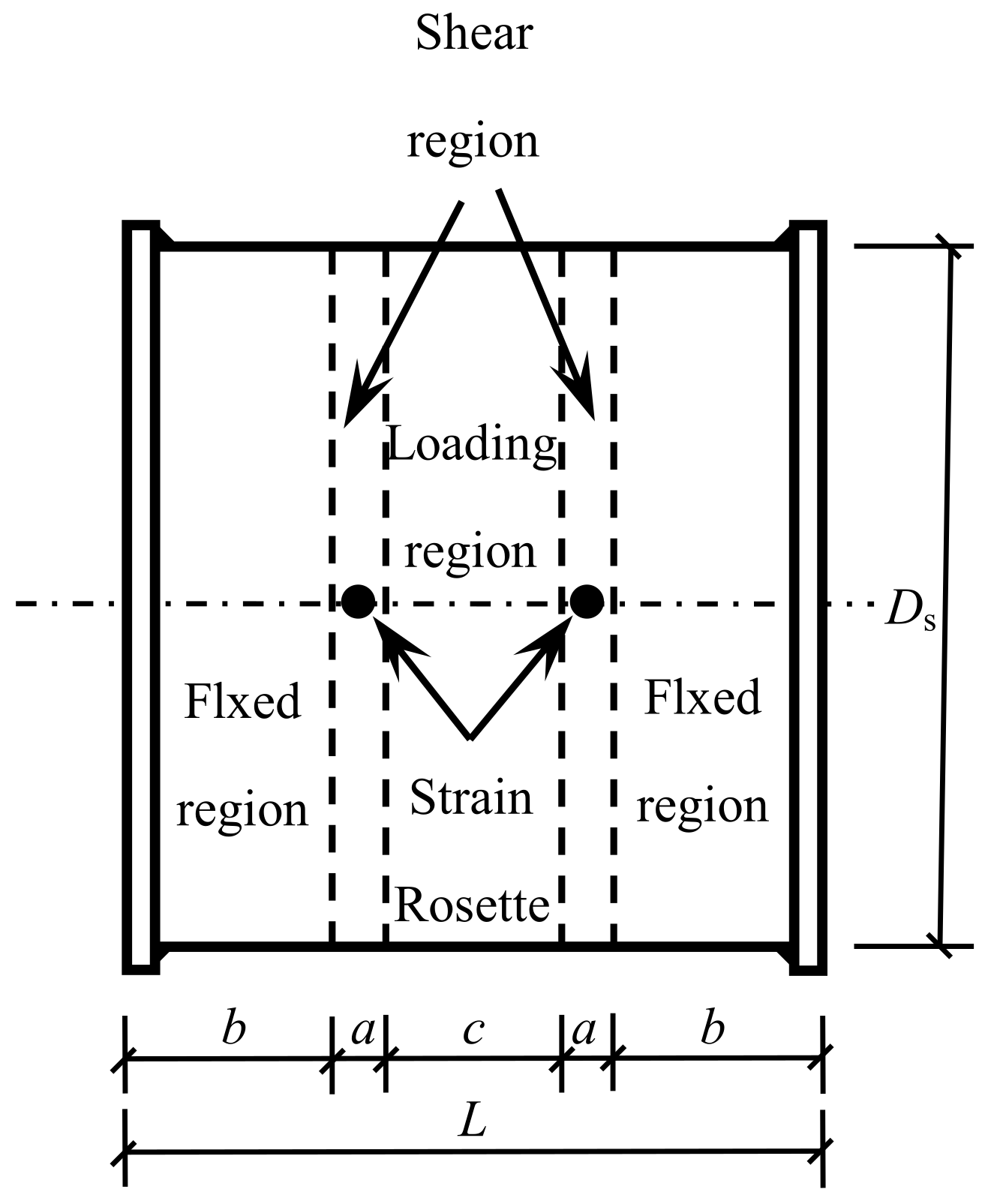

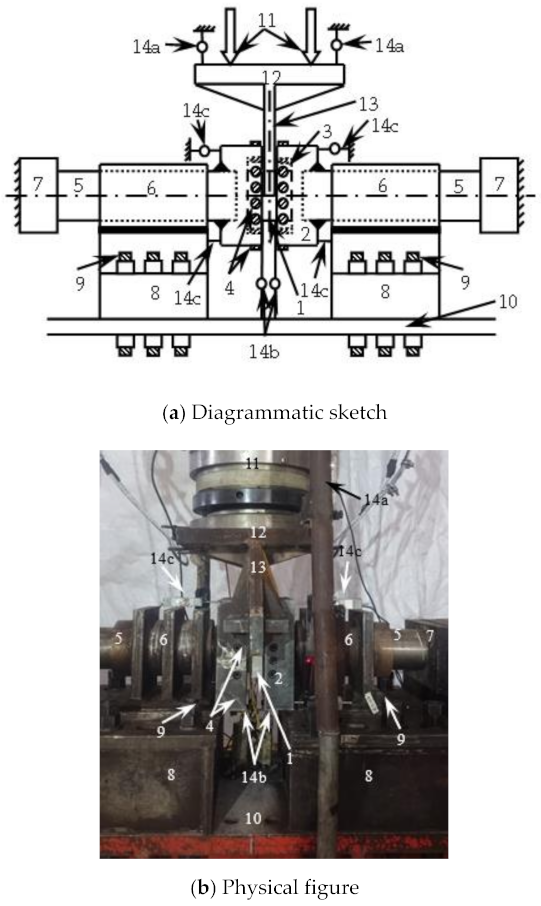

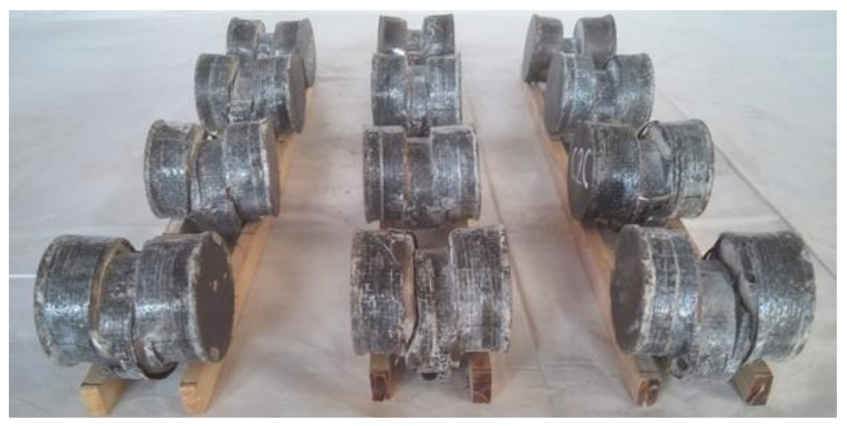





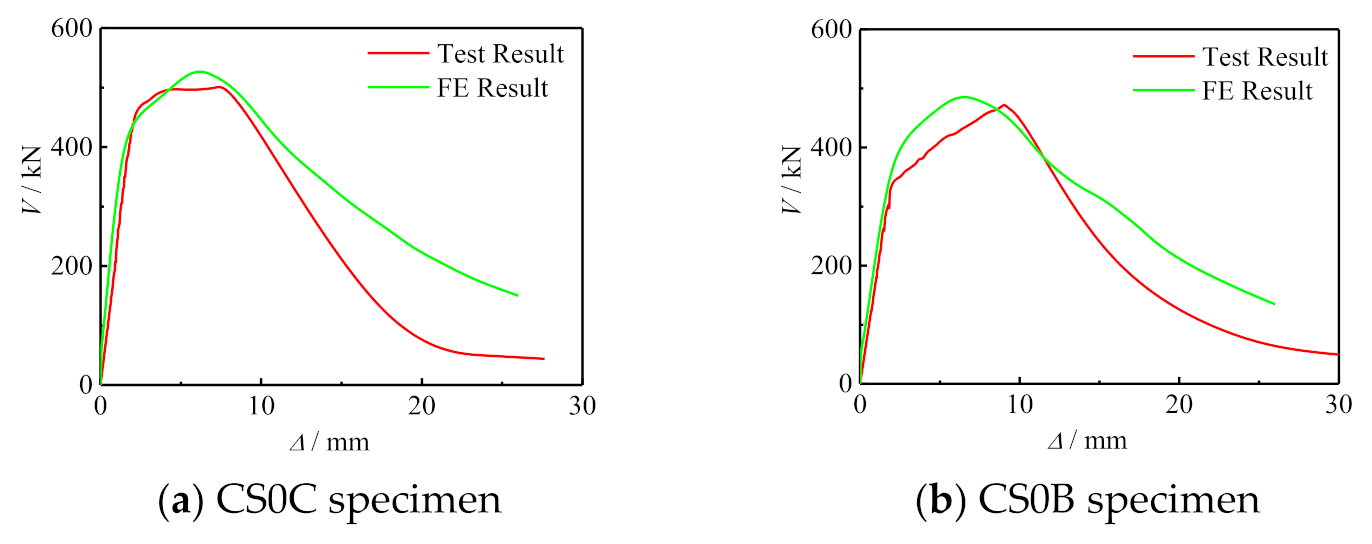

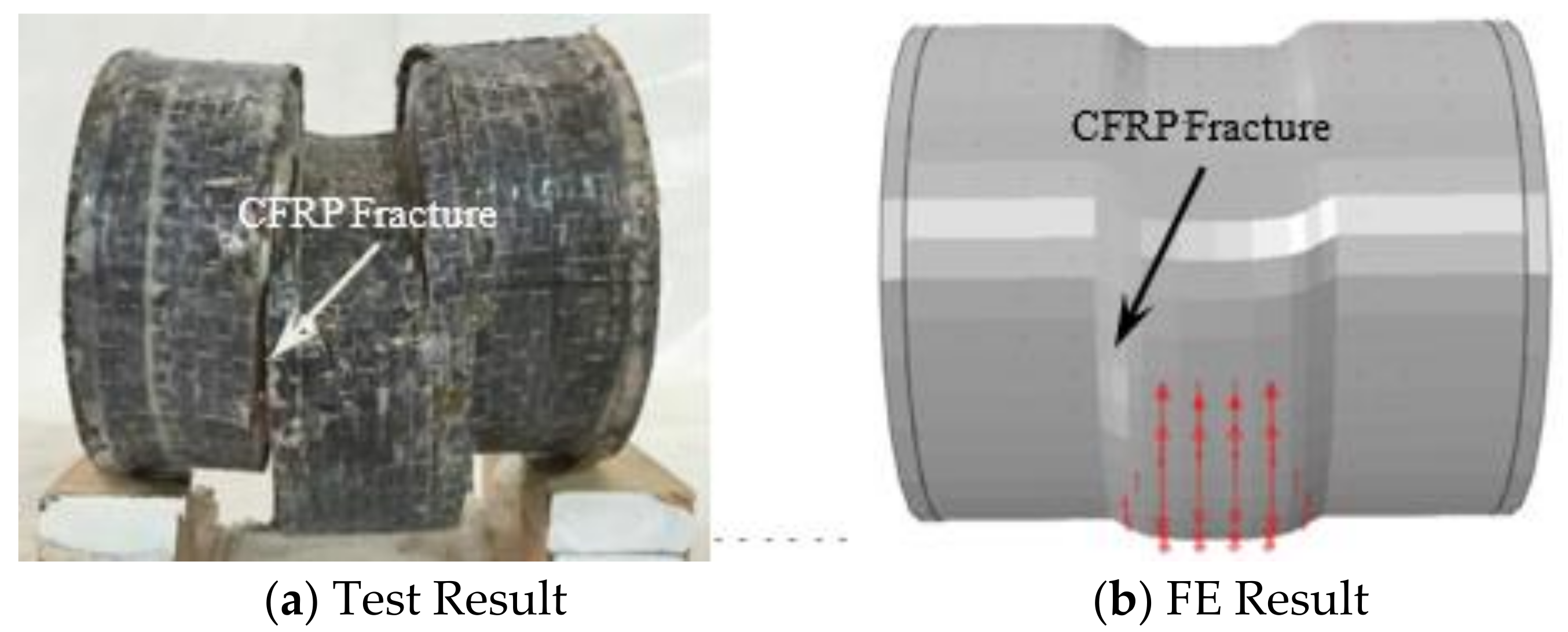

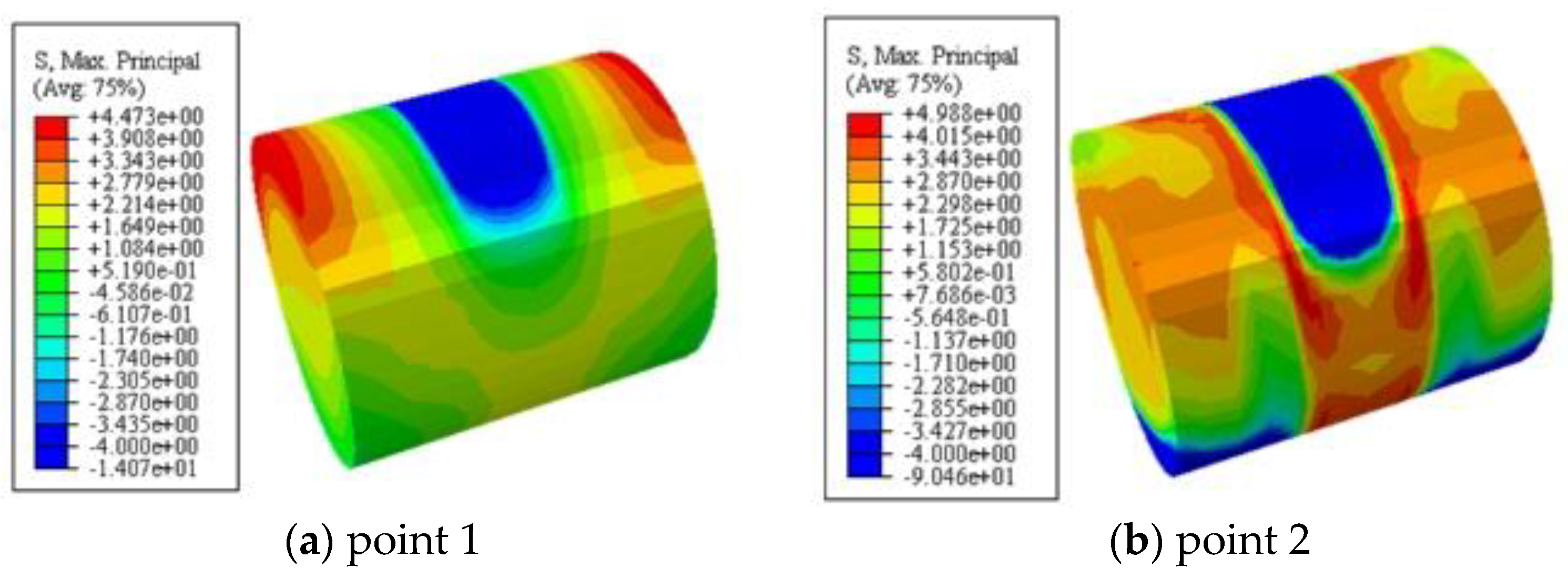
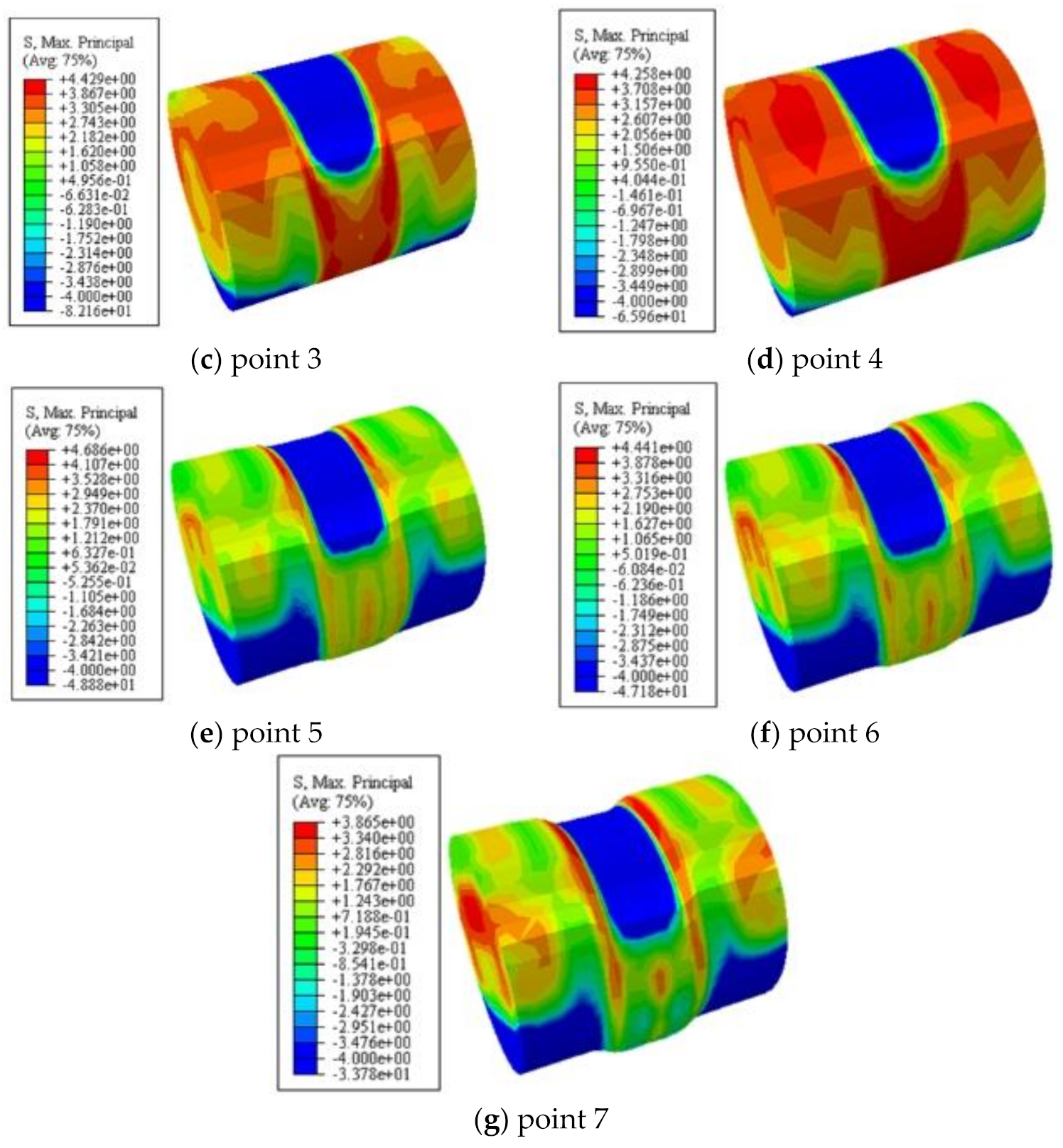
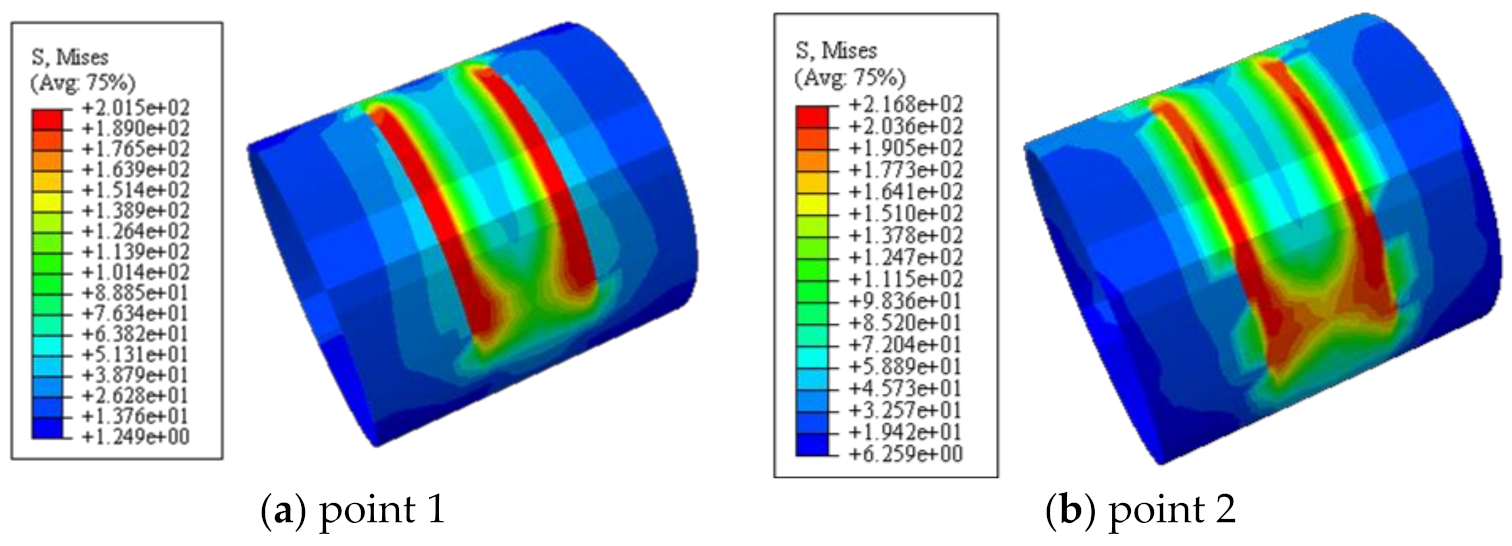

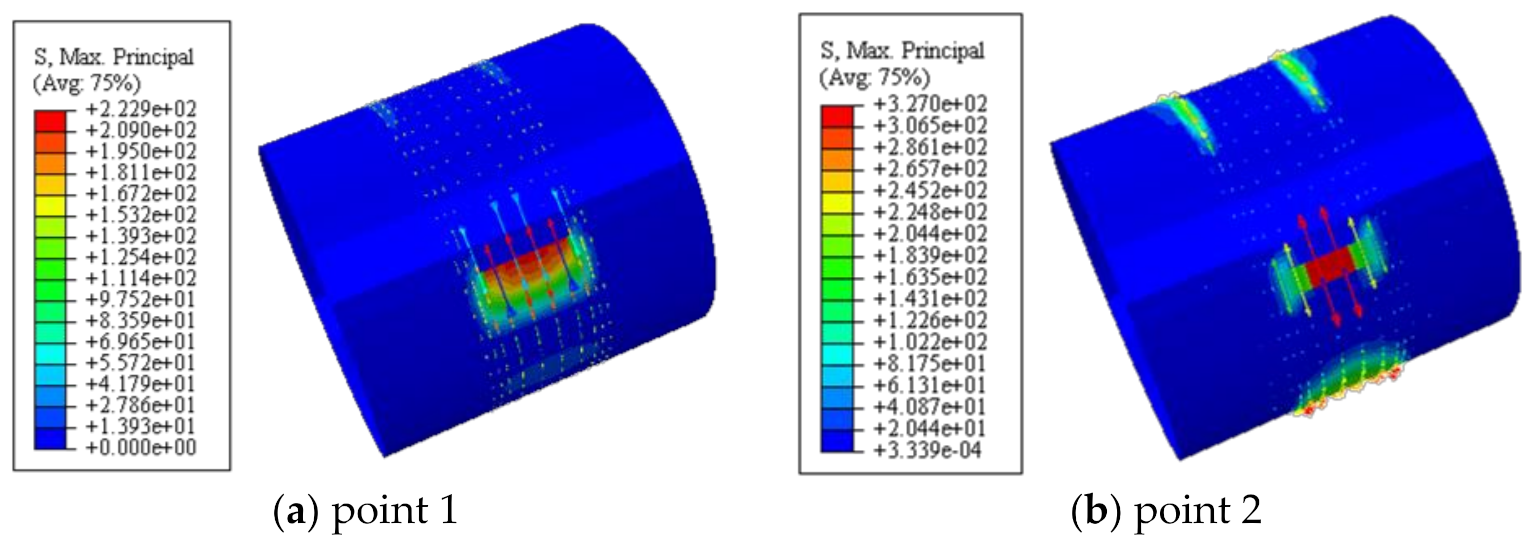
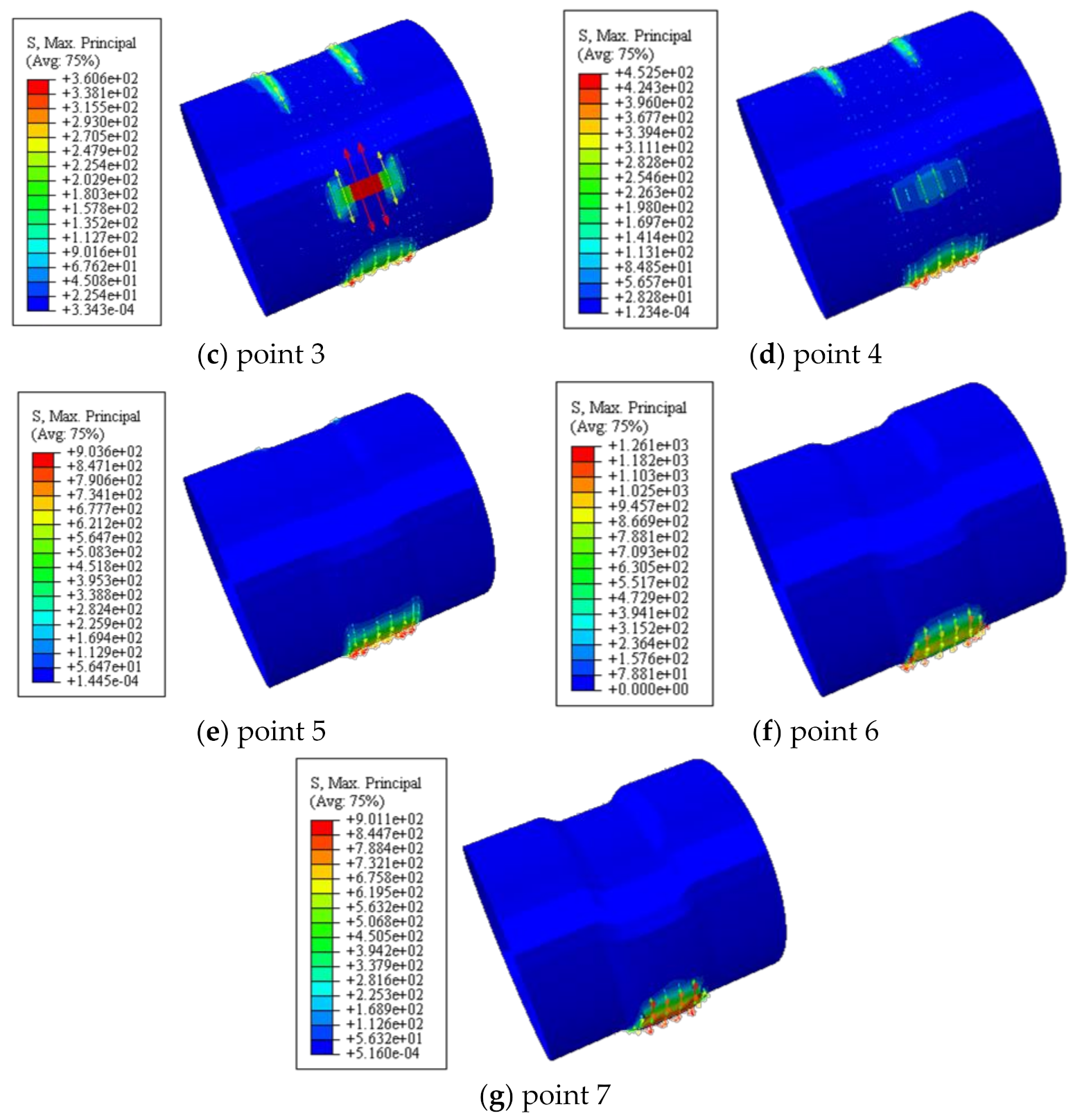


| No. | fcu | Ec | mt | ξs | ξcf | ξ |
|---|---|---|---|---|---|---|
| C0A | 35.1 | 31.5 | 0 | 1.38 | 0 | 1.38 |
| C1A | 35.1 | 31.5 | 1 | 1.38 | 0.21 | 1.60 |
| C2A | 35.1 | 31.5 | 2 | 1.38 | 0.42 | 1.81 |
| C3A | 35.1 | 31.5 | 3 | 1.38 | 0.65 | 2.02 |
| C0B | 46.1 | 33.2 | 0 | 1.05 | 0 | 1.05 |
| C1B | 46.1 | 33.2 | 1 | 1.05 | 0.16 | 1.22 |
| C2B | 46.1 | 33.2 | 2 | 1.05 | 0.32 | 1.39 |
| C3B | 46.1 | 33.2 | 3 | 1.05 | 0.49 | 1.99 |
| C0C | 54.9 | 35.5 | 0 | 0.88 | 0 | 0.88 |
| C1C | 54.9 | 35.5 | 1 | 0.88 | 0.14 | 1.02 |
| C2C | 54.9 | 35.5 | 2 | 0.88 | 0.27 | 1.15 |
| C3C | 54.9 | 35.5 | 3 | 0.88 | 0.41 | 1.29 |
| Group | C | FA | S | G | W | SP |
|---|---|---|---|---|---|---|
| A | 0.6 | 0.4 | 2.5 | 1.5 | 0.4 | 0.01 |
| B | 0.6 | 0.4 | 2 | 1.4 | 0.35 | 0.01 |
| C | 0.74 | 0.26 | 1.2 | 1.5 | 0.3 | 0.009 |
| Specimens’ Label | Initial Stiffness of Test (kN/mm) | Initial Stiffness of FE (kN/mm) | Error between Test and FE (%) | Bearing Capacity of Test (kN) | Bearing Capacity of FE (kN) | Error between Test and FE (%) |
|---|---|---|---|---|---|---|
| CS0C | 225.17 | 231.88 | 2.83 | 503.15 | 526.82 | 4.23 |
| CS0B | 164.06 | 171.77 | 4.41 | 472.121 | 483.246 | 2.73 |
| CS2B | 196.15 | 201.75 | 2.7 | 487.735 | 508.646 | 4.22 |
| CS1C | 186.78 | 204.65 | 8.73 | 493.05 | 540.371 | 9.51 |
| CS2C | 222.35 | 231.06 | 3.72 | 512.46 | 547.557 | 6.37 |
| CS3C | 239.04 | 250.17 | 4.99 | 542.96 | 552.178 | 1.93 |
Publisher’s Note: MDPI stays neutral with regard to jurisdictional claims in published maps and institutional affiliations. |
© 2022 by the authors. Licensee MDPI, Basel, Switzerland. This article is an open access article distributed under the terms and conditions of the Creative Commons Attribution (CC BY) license (https://creativecommons.org/licenses/by/4.0/).
Share and Cite
Wang, Q.; Liu, X.; Peng, K. Study on Shearing Behavior of Circular Concrete-Filled CFRP (Carbon Fiber-Reinforced Plastics)-Steel Tube. Polymers 2022, 14, 3350. https://doi.org/10.3390/polym14163350
Wang Q, Liu X, Peng K. Study on Shearing Behavior of Circular Concrete-Filled CFRP (Carbon Fiber-Reinforced Plastics)-Steel Tube. Polymers. 2022; 14(16):3350. https://doi.org/10.3390/polym14163350
Chicago/Turabian StyleWang, Qingli, Xiaokang Liu, and Kuan Peng. 2022. "Study on Shearing Behavior of Circular Concrete-Filled CFRP (Carbon Fiber-Reinforced Plastics)-Steel Tube" Polymers 14, no. 16: 3350. https://doi.org/10.3390/polym14163350





